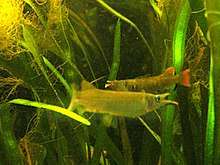Nomorhamphus ebrardtii
Nomorhamphus ebrardtii is a species of viviparous halfbeak, a ray-finned fish in the family Zenarchopteridae, endemic to brackish and freshwater locations in Sulawesi and the neighbouring island of Kabaena in Indonesia.[3] This species can reach a length of 9 cm (3.5 in) SL.
| Nomorhamphus ebrardtii | |
|---|---|
 | |
| Scientific classification | |
| Kingdom: | Animalia |
| Phylum: | Chordata |
| Class: | Actinopterygii |
| Order: | Beloniformes |
| Family: | Zenarchopteridae |
| Genus: | Nomorhamphus |
| Species: | N. ebrardtii |
| Binomial name | |
| Nomorhamphus ebrardtii | |
| Synonyms[2] | |
| |
Description
Nomorhamphus ebrardtii grows to a standard length of about 9 cm (3.5 in).[4] It is an elongate, somewhat compressed fish with the lower mandible considerably longer than the upper mandible. Alongside this there is a fold of skin which projects sideways. The beak contains no teeth but there are small pointed teeth in both jaws. The dorsal fin has ten to twelve soft rays, the anal fin fifteen and the pectoral fins twelve. The dorsal fin is shorter than the anal fin, and its origin is posterior to the origin of the anal fin. The fifth ray of the dorsal fin is the longest but is not as long as the second ray of the anal fin.[5] This is modified in males into an "andropodium", a movable intromittent organ used to deliver milt into the female's genital opening.[6] The ventral fins are small and are slightly closer to the head than to the caudal fin (a diagnostic feature) and the caudal fin is rounded. The colour of preserved specimens is yellowish and there is a dark blotch at the base of the pectoral fins.[5]
Ecology
Members of the family Zenarchopteridae show a number of different viviparous breeding strategies. Nomorhamphus ebrardtii is unusual in that the developing embryos are retained in the oviduct where they receive their nourishment from oophagy and adelphophagy, oophagy being the feeding on unfertilised eggs, while adelphophagy is the feeding on fertilised eggs, developing embryos, and smaller siblings.[7]
References
- Mokodongan, D.F. (2019). "Nomorhamphus ebrardtii". IUCN Red List of Threatened Species. 2019: e.T90981429A90981438. doi:10.2305/IUCN.UK.2019-2.RLTS.T90981429A90981438.en.
- Bailly, Nicolas (2015). "Nomorhamphus ebrardtii (Popta, 1912)". WoRMS. World Register of Marine Species. Retrieved 23 February 2016.
- Aquarium Atlas. Tetra Press. 1998. p. 1002. ISBN 978-3-88244-053-9.
- "Nomorhamphus ebrardtii (Popta, 1912)". FishBase. Retrieved 23 February 2016.
- Weber, Max Carl Wilhelm; de Beaufort, Lieven Ferdinand (1970). The Fishes of the Indo-Australian Archipelago. Brill Archive. pp. i36–139. GGKEY:Q1A23YF7NHT.
- Berra, Tim M. (2008). Freshwater Fish Distribution. University of Chicago Press. pp. 319–320. ISBN 978-0-226-04443-9.
- Meisner, A.; Burns, J. (1997). "Viviparity in the Halfbeak Genera Dermogenys and Nomorhamphus (Teleostei: Hemiramphidae)". Journal of Morphology. 234 (3): 295–317. doi:10.1002/(SICI)1097-4687(199712)234:3<295::AID-JMOR7>3.0.CO;2-8. PMID 29852651.
